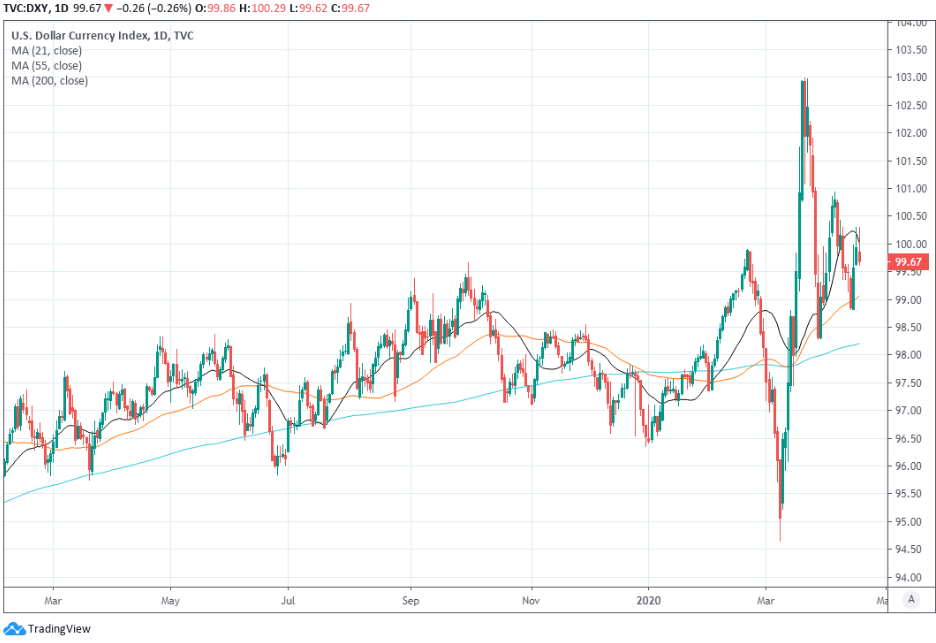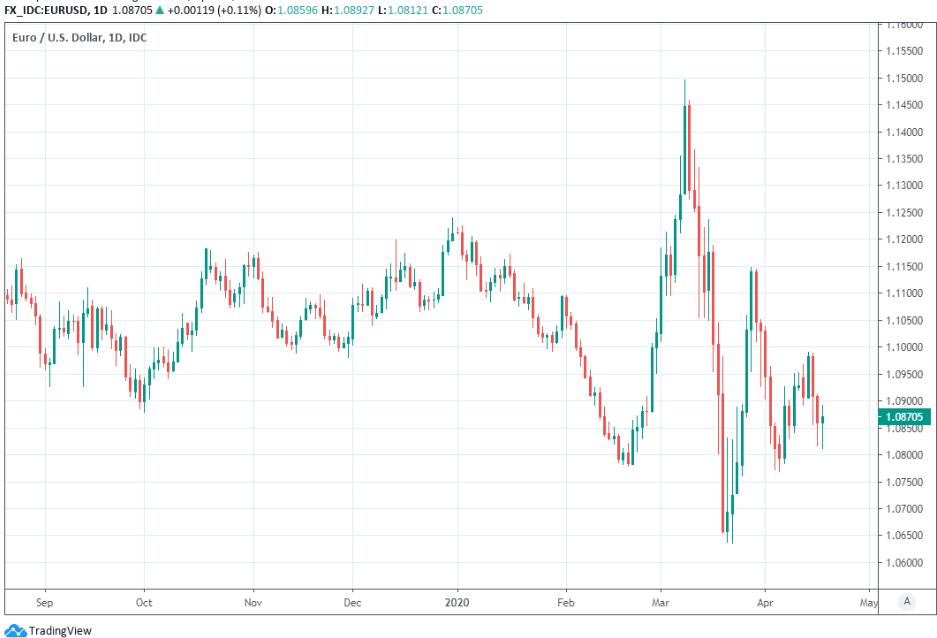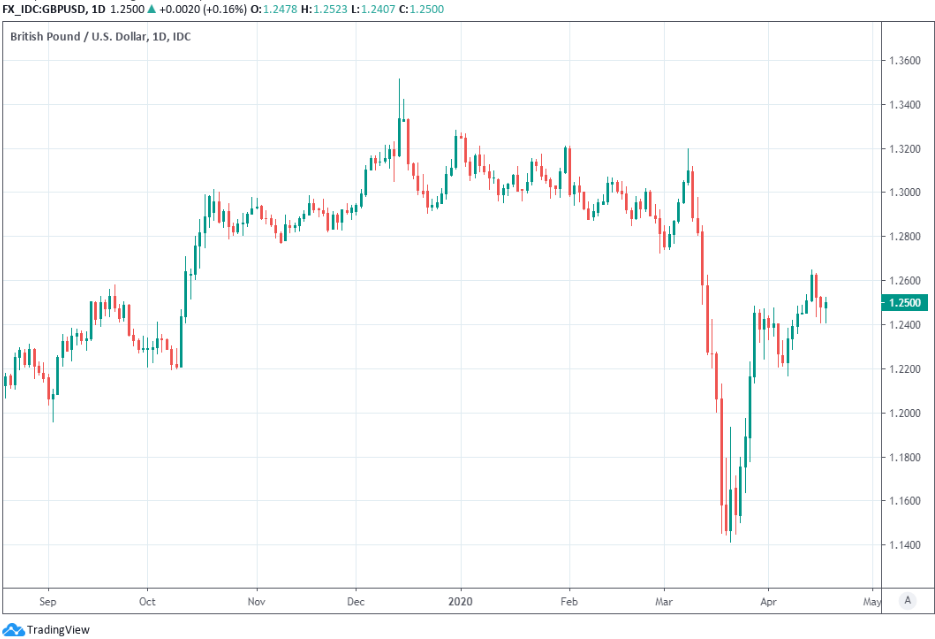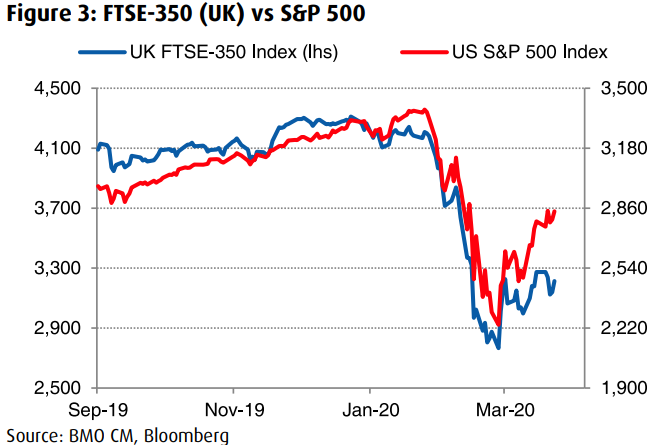U.S. Dollar Goes Out with a Whimper but Forecasters Tip Recovery and Look to Buy on Dips
- Written by: James Skinner
- USD ends week with whimper amid risk appetite recovery.
- But market has gotten ahead of itself, some analysts say.
- Uneven and bumpy road to recovery means volatility in FX.
- Lingering uncertainty, risk to lift USD, weigh on GBP/USD.

Image © Adobe Images
- GBP/USD spot at time of writing: 1.2499
- Bank transfer rates (indicative): 1.2248-1.1227
- FX specialist rates (indicative): 1.2300-1.2376 >> More information
The Dollar was set to end the week with a whimper on Friday after being undermined by a recovery of risk appetite in the North American session but forecasters are tipping the U.S. unit for a recovery over the coming weeks, which could mean there's trouble ahead for the Pound-Dollar rate.
America's Dollar was on the front foot in European trading but the North American session brought with it a spate of selling that forced the greenback lower against most of its major rivals including the Pound, with price action coming as global stock markets responded to reports of a strong performance by remdesivir, an antiviral drug produced by Gilead Sciences, in clinical trials ran by The University of Chicago Medicine.
Many analysts have said that optimism could easily prove to have been misplaced over the coming days, although stock markets had already enjoyed a raucous recovery before trial results were leaked and which has gathered pace through April. Recovering stocks and prices of some commodities are indicative of an improved appetite for risk among investors although some strategists say there's more to this bounce than meets the eye.
"It is all about the USD. In our flows, we have seen investors buying the USD dip in recent weeks, which suggests to us that they are trading the recent market rally tactically. We expect further USD strength in the weeks ahead, not because of liquidity pressures, which as we have argued the Fed has addressed, but because of the remaining CoV uncertainties and risks to the real global economy," says Athanasios Vamvakidis, head of FX strategy at BofA Global Research. "The market may have turned too optimistic...We would buy USD dips and expect JPY to become more responsive to risk."

Above: Dollar Index shown at daily intervals.
Vamvakidis says 'lockdown' measures are proving effective in curtailing the spread of coronavirus given that infection rates have declined in most places they've been used, but he's warned against inferring from this that life will return to normal in the affected economies any time soon. The U.S. set out a plan Thursday that will enable American states to lift lockdowns as soon as they feel ready, although it's still far from clear when the economy will reopen.
New York Governor Andrew Cuomo extended his lockdown until May 15 on Thursday while other big economic contributors and large polulation centres are also expected to remain under lock and key for a while yet. This could exacerbate the damage to the economy and prolong its pain, although similar is true of other countries, with knock-on effects for the Dollar and other currencies.
"The public may remain risk-averse and stay home, even after the lockdown. Unless most countries open up, the recovery in countries that do it will be weak. Progress in the CoV numbers has been too slow to suggest normalization is around the corner, in our view. The 2nd CoV wave in Asia, which has now forced Japan and Singapore to introduce more aggressive measures, in some cases for the first time, suggests that opening up too early may backfire," Vamvakidis says. "Unless there is a cure or a vaccine soon, we see a risk that the recovery will not be V or U-shaped, but an inverted J, W, or even L."

Above: Euro-to-Dollar rate shown at daily intervals.
Coronavirus has infected more than 2 million people across the globe and was present in almost every country to at least some extent on Friday, according to Johns Hopkins University data. Only a handful of small emerging market countries are omitted from the list of the infected, which may be more symptomatic of under-development than a clean bill of health, and as a result a bulk of the global economy has come close to a standstill.
This dire but possibly stabilising global situation has left Chinese policymakers in the lurch despite them having declared victory over the virus in early March, leading to a staged reopening of the world's second largest economy that culminated with the lifting of the Wuhan City lockdown last week. But as businesses reopened and citizens returned to work, policymakers have been left to confront the implications and economic headwind of an outside world that is for the time being, still in at least some form of lockdown.
Vamvakidis and the BofA team have downgraded their forecasts owing to expectations of a stronger-for-longer Dollar that stem directly from the coronavirus blindside. They now look for the Pound-Dollar rate to fall to 1.15 before the end of June but to close 2020 at 1.21, while the Euro-Dollar rate is seen hitting 1.02 in June before recovering to only 1.05 by year-end. These indicate notable upside ahead for the Dollar Index given Sterling and Euro account for two thirds of flows measured by the barometer.
"Pre-COVID-19, the dollar was one of the "stronger" global currencies. Then US yields collapsed, taking the dollar with them. Afterwards, fears of a global dollar shortage - which could re-emerge at some point - caused panic buying and pushed the dollar higher. The DXY, which is 12 parts GBP (out of 100), touched new highs for the cycle. Since then, the dollar has generally traded in a classic "risk-on/risk-off" fashion, or inversely to risk appetite. What happens from this point forward will depend very much on multiple moving parts," says Stephen Gallo, European head of FX strategy at BMO Capital Markets.

Above: Pound-to-Dollar rate shown at daily intervals.
Gallo says the ebb and flow of risk appetite explains many of the recent fluctuations in the Dollar and the Pound-Dollar rate, but that there will be more nuance to movements going forward, with the relative pace at which the coronavirus shaped hole in economies is backfilled likely to be a key theme for markets up ahead. And on this score the U.S. could be well placed to lead the field and especially as it relates to European economies.
President Donald Trump will be weighed and measured at the ballot box in November and after having ran previously on a pledge to 'make America great again', especially its economy, the White House incumbent has more direct and immediate incentive than many others to keep throwing policy mud at a crumbling economic wall in the hope that some of it sticks ahead of the election.
He'll be supported in doing this by the world's reserve currency, the Dollar, a status and 'exorbitant privilege' that just might enable him to do more in that endeavour than any other country with any other currency possibly could. All added up together this could mean a U.S. economic bounce-back that comes sooner and stronger than any of those seen elsewhere, which is a recipe for a stronger-for-longer Dollar if there ever was one.
"In our opinion, this is the type of "divergence" which needs to be reflected on in the world of COVID-19. We might also be able to infer that the equity markets are starting to make this distinction too. At the time of writing, the UK's FTSE-350 Index is up 2.0% in April, while the S&P 500 is around 10% higher over the same period," Gallo says. "To put things in a different light, there may be less capacity for the UK to support businesses and households that weren't viable before COVID-19. In the US however, the forces of "creative destruction" will probably be delayed until after the election."

Above: BMO Capital Markets graph of FTSE 350 index alongside S&P 500 index (red line).
There is only one currency with an 'exorbitant privilege' and it isn't the British one, which is hampered by the developed world's largest current account deficit that has already weighed heavily on the Pound-Dollar rate in 2020. The current account could easily bite again if an extended 'lockdown' necessitates further financial support for an economy that's already in receipt of aid worth double-digit percentages of GDP as a result of the coronavirus.
Gallo says there's a "much bigger risk" of the UK being singled out for scrutiny if-not punishment on the currency market in an extended lockdown scenario or another where the government is compelled to throw ever larger volumes of financial mud at the economic wall in order to get the economy going again. He says an adverse response by the Dollar, to more financial mud hitting the American economic wall, would be an ominous sign for Sterling.
He tips 1.26/1.27 as tough resistance for the Pound-Dollar rate in the short-term and a gradual decline back to 1.15 in time year-end, which is close to the March 2020 low of 1.1409 that was also its lowest level since 1985. BMO also forecasts a 2020 finish at 1.05 for the Euro-to-Dollar rate which, when combined with projections for Sterling, also implies notable upside for the Dollar Index.
"We would not be surprised if Brussels initially made it more difficult for the UK to sell its goods and services into the EU-27 after the transition period ends. This is one reason why our stance on GBPUSD is currently quite bearish. However, we don't think the UK's main EU-27 trading partners will have a high tolerance for trade barriers and "Brussels rigidity" in a post-COVID-19 economic landscape. All of that leaves room to debate whether a WTO Brexit will have as big an impact on the pound in the current economic climate than what might otherwise be the case," Gallo says.




